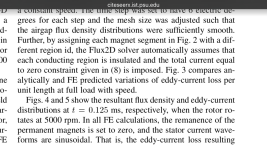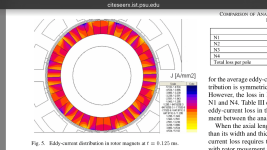ElectricGod said:madin88 said:@ ElectricGod
you mentioned non of the motors you posted pics from have electrically insulated magnets.
Couldn't it be that the magents have some kind of transparent coating for electrical insulation?
Have you measured the resistance between two magnets or what gives you this idea?
You should go back and read what I wrote. Everything you asked was addressed already.
No.
Let me write it up once more.
Above the rotor pictures you put a text with something like "magnets glued down to bare metal"
The question is:
do the magnets have a non-conductive (transparent) coating, or is it nickel coating or some other surface treatment that is electrically conductive.
I have seen magents with non-conductive coating in some chinese (geared) hub motors thats why i am asking :wink:
Is it so hard to answer this question?
ElectricGod said:A quick discussion on this eddy current loss issue. It seems that lots of little magnets is better than a few large ones for controlling this issue. Of course that means you have a motor with 200 poles to eliminate the eddy currents. Clearly there has to be a middle ground between ridiculous magnet counts and minimizing eddy losses. I think this may be the reason why hubs and outrunners have lots of magnets. This may be the place where eddy current losses are the worst so use lots of magnets. While in an inrunner, it's negligible so much fewer magnets is viable.
The pole count stays the same.
larsb has already mentioned, but it seems you did not understand
See here: LINK
ElectricGod said:To me this underlined section says that you want minimum electrical resistance between the magnets. Perhaps the problem with your motor is the exact opposite of what you think it is? Perhaps most of the magnets do NOT conduct electrically with the back iron? This is also consistent with what is observed in all of my inrunners and outrunners. AKA no insulating elements between the magnets to maximize electrical conductivity. If this is true as I interpret it, try soldering a copper loop across the tops and bottoms of your magnets to make them all electrically the same. Solder flows to chrome quite nicely. Pretin all solder locations. If you use a hot soldering iron and are quick, you won't heat up the magnet excessively before the solder flows and bonds the copper to the chrome. I bet an 18 awg strand is all that's needed top and bottom. Worst case, it doesn't work and you unsolder the wires.
IF I see lots of losses (hot magnets due to eddy losses under no load), I can do this to my motor too.
I never have soldered on magnets :lol: so i don't know how and if this can be done, but try it out and compare the no-load losses!




